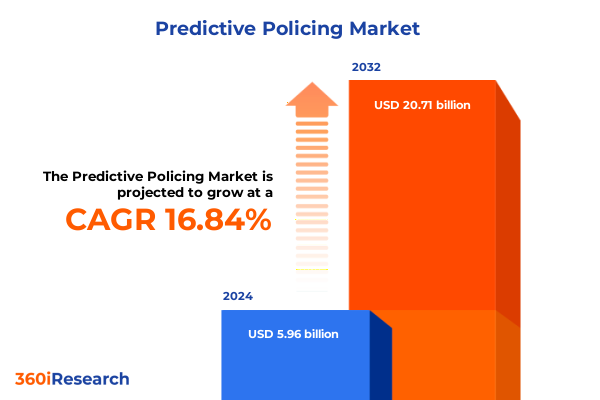The Predictive Policing Market size was estimated at USD 2.25 billion in 2024 and expected to reach USD 2.51 billion in 2025, at a CAGR of 12.53% to reach USD 5.79 billion by 2032.

Explore the transformative power of predictive policing through AI-driven analytics, strategic bias mitigation, streamlined operations, and ethical governance
Predictive policing has emerged as a cornerstone of modern law enforcement, harnessing artificial intelligence and machine learning to transform reactive crime response into proactive prevention. Law enforcement agencies across the United States are adopting data-driven models that analyze historical crime patterns to forecast potential incidents, allowing for more strategic deployment of limited resources. According to the International Association of Chiefs of Police, nearly 60% of U.S. agencies have either implemented or are considering AI-powered tools to optimize patrol planning and investigative workflows. Advances in software platforms now enable seamless integration of diverse data sources-from 911 call logs to social media feeds-into unified dashboards that support real-time decision making.
Identify key shifts transforming predictive policing, from real-time AI surveillance and IoT integration to advanced analytics for crime prevention
Law enforcement is experiencing a profound shift as agencies integrate real-time surveillance systems and Internet of Things (IoT) devices into predictive policing frameworks. Next-generation crime mapping tools leverage machine learning algorithms to correlate geographic data with crime trends, enabling commanders to anticipate hotspots with unprecedented precision. These innovations are reshaping traditional patrol models and enabling truly dynamic operational strategies.
Examine how 2025 U.S. tariff policies are impacting predictive policing technology costs, supply chains, implementation timelines, and budget allocations
The implementation of U.S. tariffs in 2025 has introduced significant cost pressures throughout the predictive policing technology stack. Critical components such as graphics processing units, tensor processing units, and field-programmable gate arrays-essential for training and running advanced AI models-are now subject to import duties as high as 25%, driving hardware cost increases of up to 30% compared to pre-tariff benchmarks. Public safety agencies and private security firms dependent on these imports have been forced to re-evaluate procurement budgets and explore alternative suppliers outside traditional manufacturing hubs.
Gain key segmentation insights into predictive policing markets by end users, application domains, service offerings, and enabling technologies driving adoption
In exploring the multifaceted nature of the predictive policing market, end users range from federal law enforcement bureaus and statewide task forces to local municipal departments, private security enterprises, and public safety agencies that extend beyond traditional policing. Applications of these tools span crime forecasting methodologies that differentiate between property crime and violent crime predictions, resource allocation solutions that include both patrol optimization and staffing projections, risk assessment engines designed for event risk analysis and suspect profiling, as well as threat detection systems capable of anomaly detection and identification of suspicious behavior. Offerings in the market bifurcate into services-encompassing consulting engagements, integration projects, and ongoing support and maintenance-and solutions characterized by analytics platforms and visualization interfaces tailored for crime pattern insights. Underpinning these services and solutions is a technology foundation built upon data mining techniques such as classification, clustering, and regression, geo mapping via GIS software and spatial analysis utilities, and machine learning approaches including reinforcement learning, supervised learning, and unsupervised learning.
This comprehensive research report categorizes the Predictive Policing market into clearly defined segments, providing a detailed analysis of emerging trends and precise revenue forecasts to support strategic decision-making.
- Offering
- Technology
- Data Source
- Crime Type
- Application
- End User
- Organization Size
Unlock regional insights into predictive policing adoption and innovation trends across the Americas, Europe Middle East Africa, and Asia Pacific markets
Regional dynamics in predictive policing reveal distinct trajectories of adoption and innovation. In the Americas, the United States leads widespread deployments of AI-enabled crime analytics, supported by strong federal grants and municipal investments that underscore a commitment to next-generation public safety solutions. Canada’s smart city initiatives are fostering cross-border collaborations that further accelerate adoption in North American urban centers. Europe, the Middle East, and Africa present a nuanced landscape shaped by rigorous data privacy frameworks, counter-terrorism mandates, and burgeoning smart city programs that integrate predictive modules into holistic urban security ecosystems. The regulatory emphasis on transparency under GDPR and similar statutes has prompted solution providers to engineer tools that meet stringent ethical and compliance requirements. In the Asia-Pacific region, rapid urbanization and government modernization efforts are driving high-growth adoption of predictive policing platforms. Investments in IoT-enabled surveillance and AI-driven analytics in countries such as China, India, Japan, and Australia have positioned APAC as the fastest-growing regional market, with smart city deployments creating new opportunities for advanced crime detection and prevention technologies.
This comprehensive research report examines key regions that drive the evolution of the Predictive Policing market, offering deep insights into regional trends, growth factors, and industry developments that are influencing market performance.
- Americas
- Europe, Middle East & Africa
- Asia-Pacific
Reveal key company profiles and competitive strategies of leading predictive policing solution providers shaping the future of public safety technologies
Leading technology providers are shaping the predictive policing market with diverse platforms and specialized solutions. Palantir’s Gotham platform remains a staple among major metropolitan police departments, offering robust data integration and pattern recognition capabilities that drive investigative efficiency. IBM’s i2 Analyst’s Notebook and Digital Policing Platform deliver advanced network analysis and case management workflows, while Axon leverages its integrated suite of body-worn cameras and cloud-based evidence management tools to feed rich data into predictive models.
This comprehensive research report delivers an in-depth overview of the principal market players in the Predictive Policing market, evaluating their market share, strategic initiatives, and competitive positioning to illuminate the factors shaping the competitive landscape.
- Altair Engineering Inc.
- Alteryx, Inc.
- Amazon Web Services, Inc.
- Cloudera, Inc.
- Dataiku
- Esri
- Fair Isaac Corporation
- Google LLC by Alphabet Inc.
- Happiest Minds
- Hewlett Packard Enterprise Company
- Hitachi Vantara LLC
- International Business Machines Corporation
- KNIME AG
- Microsoft Corporation
- Motorola Solutions, Inc.
- NTT DATA Corporation
- Oracle Corporation
- Palantir Technologies Inc.
- PredPol, Inc.
- QlikTech International AB
- Salesforce, Inc.
- SAP SE
- SAS Institute Inc.
- TIBCO Software Inc.
- VIVID EDGE CORP.
- Voyager Labs
- Axon Enterprise, Inc.
- NEC Corporation
- Hexagon AB
- Veritone, Inc.
Implement actionable recommendations to drive ethical and efficient predictive policing strategies, informed by data insights and regulatory best practices
Industry leaders must adopt actionable strategies to ensure predictive policing delivers equitable and effective outcomes. Establishing transparent governance frameworks and independent audit mechanisms can mitigate the “black box” phenomenon and build community trust, addressing concerns raised by lawmakers about opaque algorithmic decision making. Emphasizing vendor diversification and exploring domestic or non-tariff-impacted hardware suppliers will enhance supply chain resilience in the face of evolving trade policies. Furthermore, embedding bias mitigation protocols and continuous model validation processes throughout deployment lifecycles will uphold ethical standards and maintain public confidence.
Understand the rigorous research methodology combining primary interviews, secondary analysis, expert consultations, and robust data triangulation techniques
This research employs a rigorous methodology combining primary interviews with law enforcement executives, solution providers, and domain experts with secondary analysis of public filings, industry white papers, and academic literature. Data triangulation techniques were used to cross-verify insights from multiple sources, while expert consultations provided critical validation. The study also integrates both top-down and bottom-up analytical approaches to ensure comprehensive coverage of market dynamics, technology trends, regulatory influences, and competitive landscapes.
This section provides a structured overview of the report, outlining key chapters and topics covered for easy reference in our Predictive Policing market comprehensive research report.
- Preface
- Research Methodology
- Executive Summary
- Market Overview
- Market Insights
- Cumulative Impact of United States Tariffs 2025
- Cumulative Impact of Artificial Intelligence 2025
- Predictive Policing Market, by Offering
- Predictive Policing Market, by Technology
- Predictive Policing Market, by Data Source
- Predictive Policing Market, by Crime Type
- Predictive Policing Market, by Application
- Predictive Policing Market, by End User
- Predictive Policing Market, by Organization Size
- Predictive Policing Market, by Region
- Predictive Policing Market, by Group
- Predictive Policing Market, by Country
- Competitive Landscape
- List of Figures [Total: 34]
- List of Tables [Total: 1563 ]
Conclude with a strategic synthesis of how predictive policing innovations, tariffs impacts, and market dynamics converge to shape the future of public safety
In conclusion, predictive policing stands at the intersection of technological innovation and public safety imperatives, offering transformative potential to anticipate and prevent crime. However, navigating the complexities of trade policies, ethical considerations, and regional regulatory landscapes requires strategic foresight and collaborative governance. By aligning analytical capabilities with rigorous oversight, industry stakeholders can harness predictive insights to drive safer communities, optimize resource allocation, and foster trust between law enforcement and the public.
Connect with Ketan Rohom Associate Director Sales Marketing to secure predictive policing market insights and accelerate strategic decision making
Are you ready to leverage unparalleled market intelligence on predictive policing technologies? Reach out to Ketan Rohom, Associate Director of Sales & Marketing, to access the full market research report that will equip your organization with the insights needed to navigate emerging opportunities, address cost and compliance challenges, and outpace competitors in the evolving public safety landscape. Engage today to secure your strategic advantage and transform data-driven policing into actionable outcomes.

- How big is the Predictive Policing Market?
- What is the Predictive Policing Market growth?
- When do I get the report?
- In what format does this report get delivered to me?
- How long has 360iResearch been around?
- What if I have a question about your reports?
- Can I share this report with my team?
- Can I use your research in my presentation?




